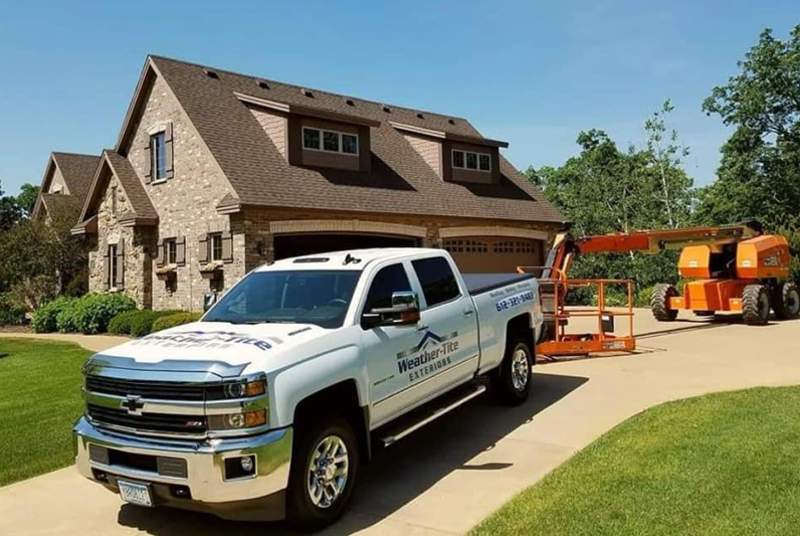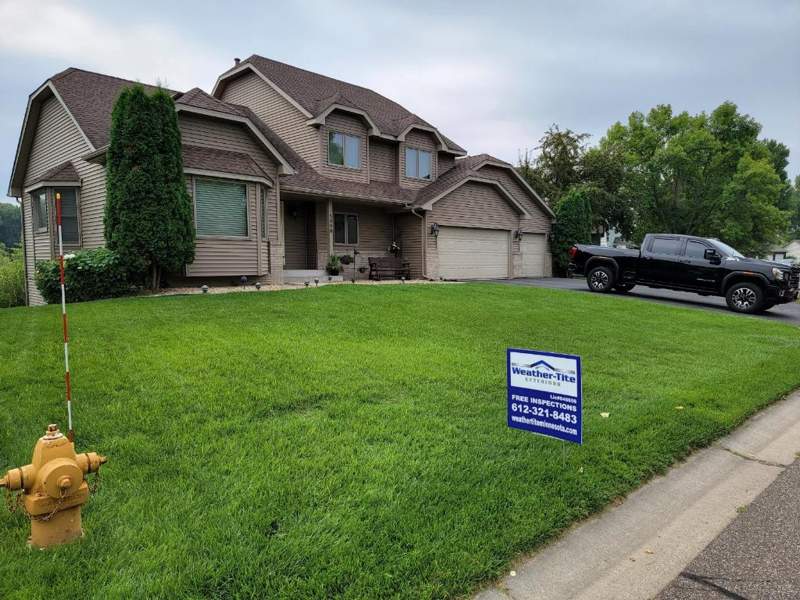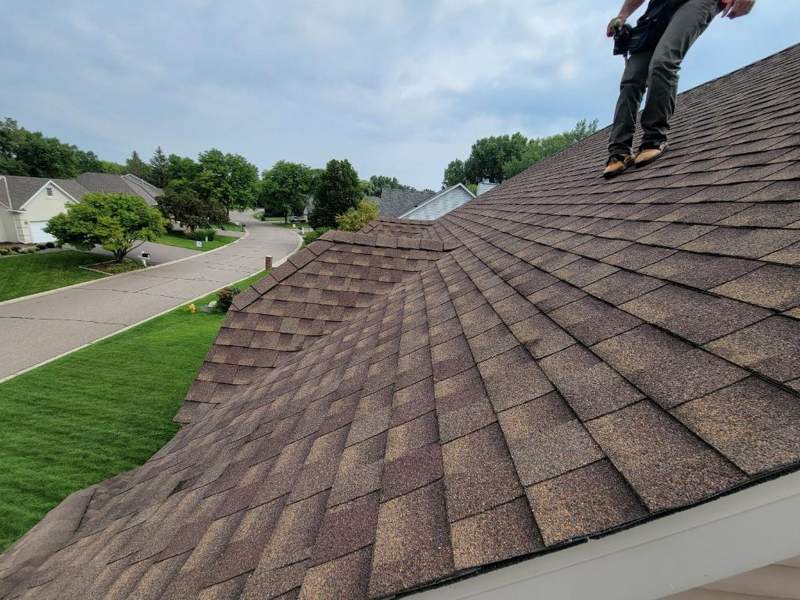About Us
With more than three decades of proven success in quality roofing, siding, gutter and window services, Weather-Tite Exteriors is your number one choice in the Twin Cities.
Read MoreContact Info
- 5200 Willson Rd Suite 150, 55424
- (612) 321-8483
- info@weathertiteminnesota.com
Contact Info
- 5200 Willson Rd Suite 150, 55424
- (612) 321-8483
- info@weathertiteminnesota.com
Roof Inspection Services Near Little Canada, MN from Weather-Tite Exteriors
-
Weather-Tite Exteriors Minnesota > Services > Roof Inspection Services Near Little Canada, MN from Weather-Tite Exteriors
Do you need a roof inspection for your Little Canada, MN home? Weather-Tite has got you covered
Your home’s roof is often the primary defense against inclement conditions, fluctuating temperatures, and other outdoor elements. That’s why it’s crucial to schedule a professional roof inspection by Weather-Tite Exteriors every year to ensure your roof’s integrity remains intact and capable of withstanding the weather.
Our skilled roof inspectors at Weather-Tite Exteriors are equipped with the necessary tools and expertise to assess the condition of your roof. Don’t wait until it’s too late – book a professional roof inspection today!

Free Roof Inspection
Same-day Service or at your availability-
Complimentary Inspection
-
Assessment of your roof repair requirements
-
100% satisfaction guaranteed
-
No service call charges. No dispatch fees
Emergency Roofing Service
Same-day Service or at your availability-
Emergency Inspection
-
Assessment of your roof repair requirements
-
Employ customized solution for your roof
-
100% Satisfaction guaranteed
Roof Replacement
Scheduled at your convenience-
Inspection and full estimate
-
Check local building codes
-
Repair and prep
-
Installation
The Roof Inspection Process
When a Weather-Tite Exteriors roof inspector arrives at your residence, they follow a complete checklist, examining for leaks, wear and tear, damage, mold, and other potential issues. The top inspection usually comprises four primary types:
Structural Inspection: During this roof inspection phase, your Weather-Tite Exteriors professional checks for any signs of sagging, unequal sections, cracks, or visible damage on your roof. Promptly addressing any structural damage is crucial, as it can pose a serious danger and lead to further injury throughout your house.
Material Inspection: This aspect of the professional roof inspection requires scrutinizing the condition of your roofing materials. The inspector looks for unfastened, curled, or missing shingles, missing flashing or fasteners, rusting, and any other material-related damages. Depending on what they find, they may examine other areas as needed.
Interior Inspection: Despite initial expectations, the inspector thoroughly examines the interior, checking ceilings, attics, and walls for signs of mold, water stains, or rot. Any visible water damage is a potential indicator of a potential roof leak, necessitating immediate attention and resolution.
Installation Inspection: This final step of the roof inspection procedure confirms the overall integrity of the roof. Property owners often opt for lower-cost installation options initially, given the significant expense of roof installation. However, such choices may result in unfinished work and installation errors, leading to issues like incorrect flashing around chimneys, skylights, and vent pipes, eventually causing leaks and severe roof-related damage.

Are you wondering about the indicators that indicate you might require a rooftop inspection?
While scheduling routine yearly roof inspections is essential, there are several indicators that warrant additional attention. If you observe any drips or noticeable breezes, reaching out to Weather-Tite Exteriors for a roof inspection at your residence is advisable.
Visible water leaks and stains on your ceiling or walls imply potential roof issues, which requiring a prompt inspection from Weather-Tite Exteriors.
How often should you arrange a roof inspection?
It is recommended to have a professional roof inspection by Weather-Tite Exteriors at least once annually. Optimal times for a roof inspection on your home are early fall or spring, minimizing weather-related risks and associated hazards for the roof inspector. Additionally, if a severe storm has affected your area, contacting Weather-Tite Exteriors for a thorough roof inspection can prevent significant long-term expenses.
If you need more information on the signs that indicate you may need a roof inspection, check this article.
More on the city of Little Canada, MN
Little Canada, MN
Here are the links to the Wikipedia page and the city hall website for Little Canada, MN:
Storm Damage Repair
Frequently Asked Questions
Is Weather-Tite Exteriors Licensed & Insured?
Yes! We’re a licensed building contractor in the state of Minnesota. Our license number is BC648656. Weather-Tite Exteriors carries $2,000,000 in general liability insurance.
What Kind Of Experience Weather-Tite Exteriors Has In The Roofing & Construction Business?
Since 1990, Weather-Tite Exteriors has been providing roofing and other exterior services. Check our reviews section and our projects page for more.
How Thorough Are Weather-Tite Technicians While Performing a Roof Inspection?
We take Inspections very seriously. A thorough analysis of your roofing system is necessary to determine the scope of the work needed.
Does Weather-Tite Exteriors Check for Proper Ventilation During an Inspection?
Yes! Ventilation is an important part of your roofing system. A proper assessment and ventilation plan are necessary to ensure that your new roof performs at an optimal level. Weather-Tite Exteriors will inspect and determine the best course of action for your ventilation needs. Give us a call now and we’ll be glad to discuss the possibilities with you.
Will Weather-Tite Technicians Explain How A Roofing System Works?
Yes! It’s important that the homeowner knows how the system functions, and that a proper maintenance schedule is put in place.
Will Weather-Tite Exteriors Provide Options For Shingle Styles & Colors?
Yes! Weather-Tite Exteriors has access to all of the latest styles and colors available. Check our projects page for more.
Can Weather-Tite Exteriors Provide References For Their Work In My Area?
Yes! With more than 30 years of experience Weather-Tite Exteriors has many references available for you. Check our reviews section and our projects page for more.
Will Weather-Tite Exteriors Be Transparent About The Time Needed to Complete My Project?
Yes! It’s important for the homeowner to understand the timing of the project and how different events like weather might affect the schedule.
Will Weather-Tite Exteriors Offer Financing Options?
Yes! Weather-Tite Exteriors has several financing options available for your needs. Learn more on our Financing Options page.
What should I do prior to the roofing installation?
At Weather-Tite Exteriors, we’re excited to embark on your roof installation journey! To ensure a seamless experience, here are some quick prep tips for your home:
Clear the Landing Zone:
Park it Further:
Move your car(s) away from the house, ideally to the street, to give our crew and equipment plenty of room to work their magic.
Move the Movable:
Patio furniture, grills, decorations – anything that could get caught in the action – needs to be relocated away from the house.
Mow Low:
Keeping your lawn short allows our team to move around freely and makes post-installation cleanup a breeze. Those magnetic nail rollers work wonders, but tall grass can slow them down!
Prep Your Indoor Oasis:
Dust Busters:
Dust and debris can sneak in during installation. Cover furniture, electronics, and other valuables in the attic, bedrooms, and living areas with drop cloths or dust sheets.
Wall Art Wanderlust:
Vibrations from hammering might give your wall decor a case of the jitters. Take down any pictures or decorations to prevent unwanted tumbles.
Attic Access All Clear:
Make sure the attic hatch or door is easily accessible for our roofers. Remove any boxes or stored items blocking the entryway.
Peace of Mind for Everyone:
Lockdown the Latches: Keep windows and doors closed and locked to prevent dust and debris from entering your home.
Neighborly Nods:
Inform your neighbors about the upcoming installation, so they’re aware of any potential noise or inconvenience.
Pet Pals and Kid Care:
The installation process can be lively. Consider boarding your furry friends or finding alternative arrangements for children during the installation period.
Power Up and Flow:
Our crew may need access to power outlets and water for various tools and cleaning. Let us know where these are readily available beforehand.
Bonus Tips:
Communication is Key:
Don’t hesitate to reach out to our dedicated team with any questions or concerns you may have before or during the installation. We’re always happy to help!
Branch Out (Safely):
If large branches hang over your roof, consider trimming them back to give our crew easier access and avoid potential damage during the installation.
By following these simple steps, you’ll be well on your way to a smooth and successful roof installation with the Weather-Tite Exteriors team! We look forward to transforming your home’s protection and adding lasting value.
What is the best time of the year to install a new roof?
When it comes to installing a new roof, timing is crucial. The ideal time for installation depends on various factors, including your location and local weather patterns. Here’s a breakdown of the pros and cons of different seasons for roof installation:
Fall (Generally Considered the Best)
- Pros: Comfortable temperatures, less rain compared to spring, allows shingles to properly set before winter.
- Cons: Often the busiest season for roofers, potentially leading to higher prices and longer wait times.
Spring
- Pros: Milder temperatures compared to winter, allows for repairs before potential summer storms.
- Cons: Spring showers can delay projects, and unpredictable weather can pose challenges.
Summer
- Pros: Long daylight hours can speed up the installation process.
- Cons: Extremely hot temperatures can be uncomfortable for workers and may negatively impact the performance of some roofing materials. Additionally, rain can still be an issue.
Winter
- Pros: Lower demand for roofers can lead to better pricing and availability.
- Cons: Cold temperatures can make working conditions difficult and may prevent the proper application of some materials. Additionally, snow and ice can pose safety hazards for workers.
Additional factors to consider:
- Local weather patterns: Research the average temperatures and rainfall patterns in your area throughout the year to determine the most stable and predictable season for roof installation.
- Material limitations: Some roofing materials might have specific recommendations regarding installation temperatures. Discuss this with your roofing contractor to ensure the chosen material is suitable for installation during the chosen season.
- Availability of roofing contractors: Depending on your location, the demand for roofers may vary throughout the year. Consider scheduling your installation during a time when reputable contractors are readily available.
Why are my roof granules falling off shingles?
Understanding Roof Granule Loss
Are you noticing granules falling off your shingles? Here are some insights to help you understand the possible causes:
- Normal Aging:
This is the most common cause. Asphalt shingles naturally lose some granules over time due to weathering:
- Sun exposure: UV rays degrade the asphalt, making it lose its grip on the granules.
- Temperature fluctuations: Extreme heat and cold can cause the asphalt to expand and contract, loosening the bond with the granules.
- Wind and rain: These forces can physically wear away at the granules and wash them off the roof.
Physical Damage:Events like these can cause sudden and significant granule loss:
- Hail damage: The impact of hailstones can knock granules off the shingles.
- Debris: Falling branches, wind-blown objects, or even people walking on the roof can scrape off granules.
- Improper installation: If the shingles weren’t installed correctly, the granules may not be properly adhered and more prone to falling off.
New Roof Installation:It’s actually normal to see some granule loss right after a new roof installation. The shingles are handled, cut, and nailed during installation, which can loosen some granules. This initial loss shouldn’t be significant and should stop soon after.
Assessing the Severity:
Here’s how to gauge the seriousness of the situation:
- Extent of loss: A small amount of granule loss in specific areas is likely normal aging. However, widespread and significant loss is concerning.
- Age of your roof: If your roof is near the end of its lifespan (around 20-25 years for asphalt shingles), even moderate granule loss could indicate it’s time for a replacement.
- Exposed asphalt beneath granules: If you see large patches of exposed asphalt, your roof is likely compromised and may need urgent repair or replacement.
Taking Action:
What should you do next?
Inspect your roof safely: If you’re comfortable, visually inspect your roof for signs of extensive granule loss, exposed asphalt, or other damage.
Consult a professional: If you’re unsure about the severity of the problem or have concerns, it’s highly advisable to get a professional roof inspection by a qualified contractor. They can assess the situation, recommend solutions, and advise on repairs or replacement.
Remember, it’s crucial to address roof problems promptly to prevent further damage and protect your home.
For a FREE professional roof inspection, contact Weather-Tite Exteriors at (612)321-8483.
What services does Weather-Tite Offer?
At Weather-Tite Exteriors Minnesota, we specialize in roofing, siding, and gutter installations and repairs! Your home is in safe hands with our experienced team.
How can I get a roof inspection?
It’s easy! Just visit our website at https://weathertiteminnesota.com/schedule-appointment and fill out the form or give us a call. We’re here to help you every step of the way
Do you offer emergency roof repair services?
Absolutely! We understand that emergencies happen. Our team is ready to handle your urgent roofing needs professionally and promptly.
Can you help with insurance claims for storm damage?
Of course! We have experience dealing with insurance claims and can assist you in making the process as smooth as possible.
What materials do you use for roofing?
We use high-quality materials like asphalt shingles, metal roofing, and more! We tailor our recommendations to fit your home’s needs and aesthetic.
Do you offer financing options?
Yes, we do! We understand home repairs can be an unexpected expense, so we offer flexible financing options to help you manage costs.
Accordion Title
Our Service Area
- Antlers Park
- Apple Valley
- Arden Hills
- Argonne
- Armstrong
- Atwood
- Augusta
- Baden
- Banfill Island
- Barden
- Big Island
- Blaine
- Bloomington
- Boom Island
- Brooklyn Center
- Brooklyn Park
- Bug Island
- Burnsville
- Calhoun Beach
- Cardigan Junction
- Carver
- Carver Beach
- Cedar Grove
- Champlin
- Chanhassen
- Chase Island
- Chaska
- Circle Pines
- Coates
- Columbia Heights
- Coon Creek
- Coon Rapids
- Corcoran
- Crane Island
- Credit River
- Crescent Beach
- Crystal
- Crystal Bay
- Dahlgren
- Deephaven
- Deer Park
- Deering Island
- Ditter
- Duck Island
- Dunn Island
- Dupont
- Durnam Island
- Eagan
- Eagle Island
- Eden Prairie
- Edina
- Enchant Island
- Eureka
- Excelsior
- Falcon Heights
- Fridley
- Frog Island
- Gale Island
- Gem Lake
- Gladstone
- Glen Lake
- Glendale
- Glenwood Junction
- Gloster
- Golden Valley
- Goose Island
- Grainwood
- Greenwood
- Groveland
- Hall Island
- Hamel
- Harriet Island
- Hazel park
- Hazeltine
- Hennepin Island
- Highwood
- Hilltop
- Hoffmans Corner
- Hopkins
- Independence
- Inver Grove Heights
- Island Park
- Jonathan
- Kenwood Gables
- Lake Shore Park
- Lakeville
- Landfall
- Lauderdale
- Leighton
- Lexington
- Light-House Island
- Lilydale
- Little Canada
- Lone Tree Island
Get a Free Inspection
Roofing Services




